When a deadbolt becomes stuck in the locked position, it can be a frustrating and potentially serious problem. This issue might prevent you from accessing your home or securing it properly when you leave.
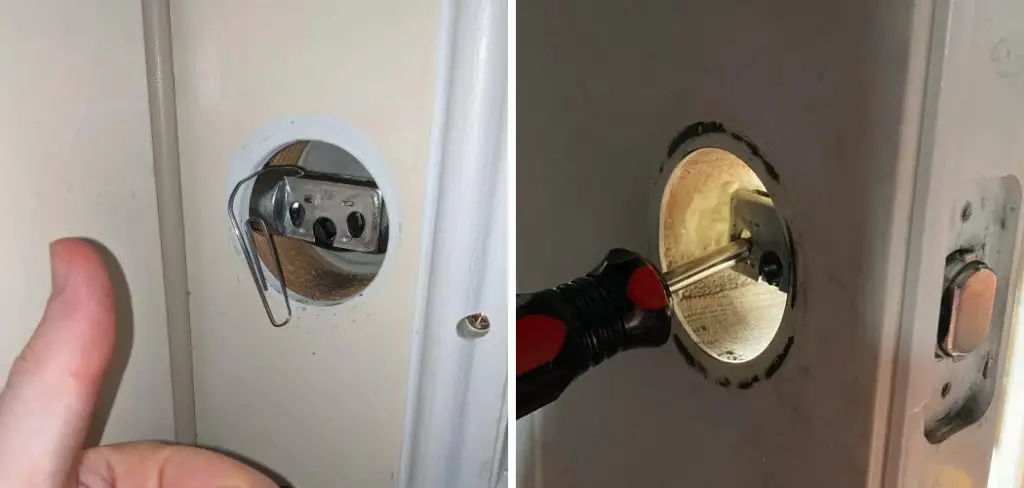
Deadbolts can become stuck due to various reasons, such as internal misalignment, debris buildup, or even wear and tear over time. Understanding how to safely and effectively address this problem can save you the hassle and expense of calling a locksmith.
In this guide on how to remove deadbolt stuck in locked position, we’ll walk you through the steps to troubleshoot and remove a deadbolt that’s jammed, ensuring your home remains secure and accessible.
Why Is My Deadbolt Stuck in the Locked Position?
Before we dive into the steps to remove a stuck deadbolt, it’s important to understand why this happens. Some common reasons for a deadbolt getting jammed include:
Misaligned Strike Plate:
The strike plate is the metal piece attached to the door frame that catches the bolt when you lock your deadbolt. If it’s not aligned properly with the bolt, it can cause the deadbolt to get stuck. This can happen due to loose screws, warping of the door frame, or shifting of the house foundation.
Debris Buildup:
Dirt, dust, and other debris can accumulate in the deadbolt mechanism over time. This buildup can prevent the bolt from retracting fully when you unlock it, causing it to get stuck in the locked position.
Worn Out Parts:
Like any mechanical device, deadbolts can experience wear and tear over time. If certain parts of your deadbolt such as the springs or pins are worn out or broken, it can cause the bolt to become jammed.
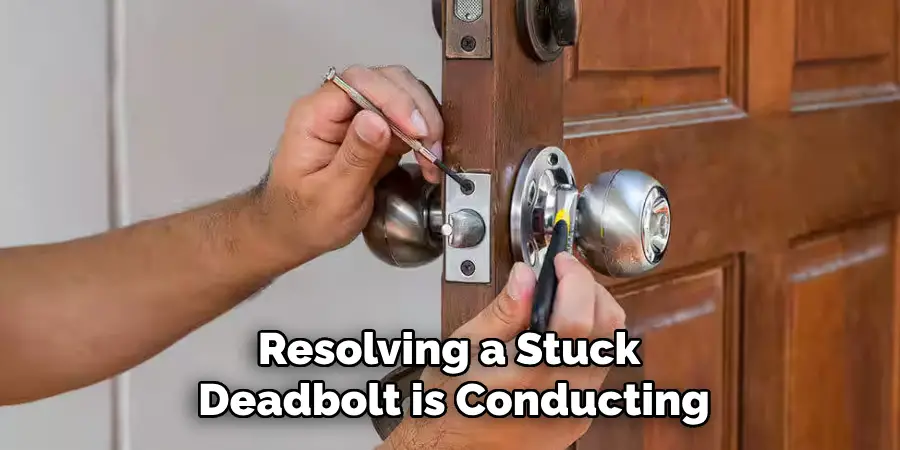
8 Simple Step-by-step Guidelines on How to Remove Deadbolt Stuck in Locked Position
Step 1: Inspect the Deadbolt
The first step to resolving a stuck deadbolt is conducting a thorough inspection of the lock mechanism. Begin by examining the deadbolt closely for any visible signs of damage or obstruction. Check if the key turns smoothly in the lock cylinder or if there is noticeable resistance. Ensure that the strike plate is aligned correctly with the bolt hole in the door frame.
Look for any loose screws or warped sections in the door or frame that might be affecting the alignment. Additionally, inspect the deadbolt for any debris or dirt accumulation that might be interfering with its movement. Identifying these issues can help determine the appropriate solution and prevent unnecessary removal attempts or further damage.
Step 2: Lubricate the Lock
If the key turns smoothly in the lock cylinder, but the bolt still won’t retract, try lubricating the lock. Use a penetrating oil or graphite powder to lubricate the lock mechanism and help free up any stuck pins or springs.
Spray or apply the lubricant directly into the keyhole and then insert your key to work it inside for a few minutes. This should help loosen any debris buildup that might be causing the issue.
Step 3: Try a Different Key
If lubricating the lock doesn’t work, try using a different key. Sometimes, worn or damaged keys can cause the deadbolt to get stuck in the locked position. If you have a spare key, try using it to see if it solves the problem.
The new key might be able to push aside any dirt or debris that the old key couldn’t and successfully unlock the deadbolt. If this doesn’t work, proceed to the next step.
Step 4: Use a Hammer and Pliers
This method requires some caution as it involves using force on the deadbolt. Begin by using pliers to grip and pull onto the key while turning it in an attempt to retract the bolt. Apply gentle pressure and avoid pulling too hard as this could break your key inside the lock.
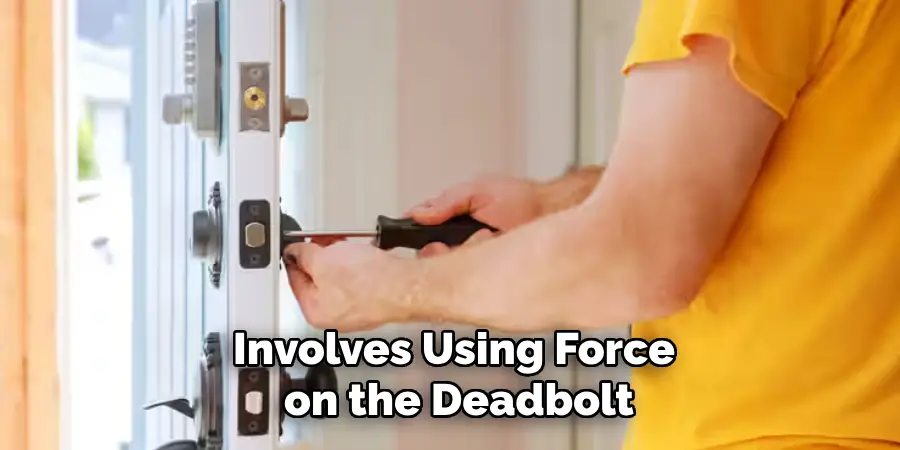
If this doesn’t work, use a hammer or mallet to tap gently on top of the pliers while pulling back on them with steady pressure. This can help dislodge any stuck pins or debris and release the bolt.
Step 5: Remove the Strike Plate
If none of the above methods work, it’s time to remove the strike plate from the door frame. This will give you access to the deadbolt mechanism and allow you to troubleshoot and solve the issue more directly.
Remove the screws that hold the strike plate in place using a screwdriver or drill. Then, use a flat-head screwdriver or chisel to gently pry off the strike plate. Take care not to damage your door frame while doing this.
Step 6: Troubleshoot Internal Issues
With the strike plate out of the way, inspect both sides of the deadbolt mechanism for any visible damage or obstructions. Check if the bolt is properly aligned with the hole in the strike plate and if there are any broken or worn-out parts.
If you notice any issues, try using a screwdriver or pliers to manually move and release the bolt. If this doesn’t work, it might be time to replace some of the damaged parts or call a locksmith for assistance.
Step 7: Clean and Replace Parts
If the deadbolt mechanism is free from visible damage but still won’t budge, try cleaning it thoroughly with a cloth and some lubricant. You can also use compressed air to blow out any dirt or debris that might be stuck inside.
If the bolt still won’t move, it’s possible that certain parts, like the springs or pins, have worn out and need to be replaced. You can purchase replacement parts from a hardware store or call a locksmith for assistance.
Step 8: Reinstall the Strike Plate
Once you’ve resolved any internal issues and cleaned the deadbolt mechanism, it’s time to reinstall the strike plate. Place it back on the door frame and use screws to secure it in place. Test the lock by inserting your key and turning it to ensure that the bolt retracts smoothly.
Congratulations, you have successfully removed a deadbolt stuck in a locked position! Remember to keep your lock well-maintained and regularly lubricate it to prevent these issues from happening in the future. If you encounter any difficulties or damage during the process, it’s best to call a professional locksmith for assistance. So, always stay vigilant and keep your home safe by ensuring that all your locks are functioning properly.
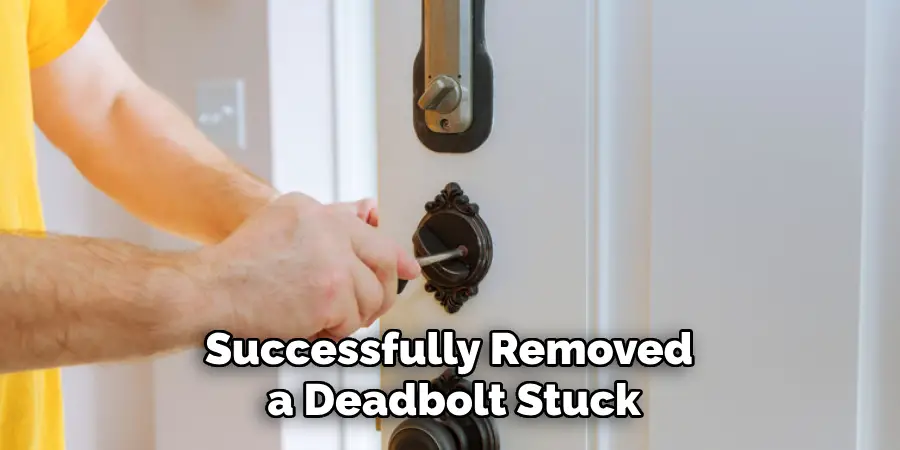
How Much Does It Cost to Call a Professional Locksmith?
The cost to hire a professional locksmith can vary significantly based on several factors, including your location, the complexity of the job, and the time of day or week. On average, you can expect to pay between $50 and $150 for a residential locksmith to handle a basic lockout or rekeying service. However, if you require more specialized services, such as those for high-security locks or electronic systems, prices can rise up to $250 or more.
Emergency services, especially those outside normal business hours like nights, weekends, or holidays, may incur additional charges, often leading to a service fee of $150 to $300. It’s important to ask for a quote in advance to avoid surprises and ensure that you’re getting a fair price for the locksmith services you need. Always verify the locksmith’s credentials and consider opting for a certified professional to ensure quality and reliability.
Additional Tips
- Regularly clean and lubricate your deadbolt to prevent the buildup of dirt and debris.
- Use spare keys when possible to avoid using worn or damaged keys on your deadbolt.
- Be cautious while applying force to remove a stuck deadbolt as this can lead to further damage.
- If all else fails, seek assistance from a professional locksmith instead of forcing the lock open yourself. Allowing someone who is trained and experienced to handle the issue can prevent further damage and ensure that your lock is properly fixed. So, don’t hesitate to call for help when needed. As they say, it’s better to be safe than sorry. Stay safe and secure!
Following these tips on how to remove deadbolt stuck in locked position can help prevent your deadbolt from getting stuck in the locked position and save you time, money, and stress. Remember to always prioritize the safety and security of your home by keeping your locks well-maintained and addressing any issues promptly. Happy lock troubleshooting!
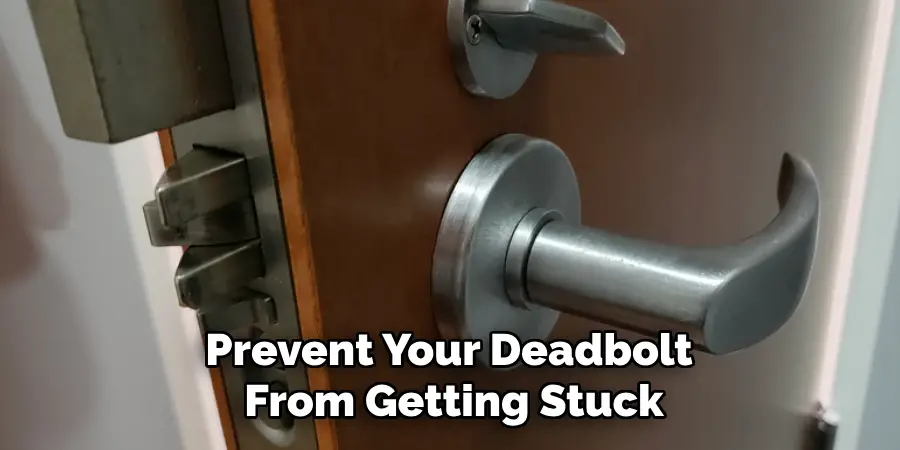
Frequently Asked Questions
Q: How Often Should I Clean and Lubricate My Deadbolt?
A: It is recommended that you clean and lubricate your deadbolt at least once every six months. However, if you notice any issues with the lock, such as difficulty turning the key or a sticky bolt, it’s best to clean and lubricate it right away. The more regularly you maintain your deadbolt, the less likely it is to get stuck in the locked position.
Q: Can I Use Any Type of Lubricant on My Deadbolt?
A: No, it’s important to use a lubricant specifically designed for locks and not just any household lubricant. Graphite powder or penetrating oil are both good options for lubricating your deadbolt as they won’t attract dirt and debris like other types of lubricants.
Q: Is It Possible to Prevent a Deadbolt from Getting Stuck in a Locked Position?
A: While there is no foolproof way to prevent a deadbolt from getting stuck, regular maintenance and proper usage can greatly reduce the chances of it happening. Avoid using excessive force when locking or unlocking your deadbolt and make sure to replace any damaged keys promptly. Additionally, installing a high-quality deadbolt from a reputable brand can also decrease the likelihood of issues occurring.
Q: Can I Remove a Stuck Deadbolt Myself or Should I Seek Professional Help?
A: It depends on the severity of the issue and your level of expertise in lock troubleshooting. If you feel confident in your abilities and have tried all the steps outlined above with no success, you can attempt to remove the stuck deadbolt yourself by following safety precautions and being gentle with the lock. However, if you encounter difficulty or notice any damage, it’s best to call a professional locksmith for assistance.
It may cost more upfront, but it can save you from potential hassle and expenses in the long run. So, always prioritize safety and security first before trying to fix the issue yourself. If you’re unsure or uncomfortable with handling the situation, it’s better to leave it to the experts.
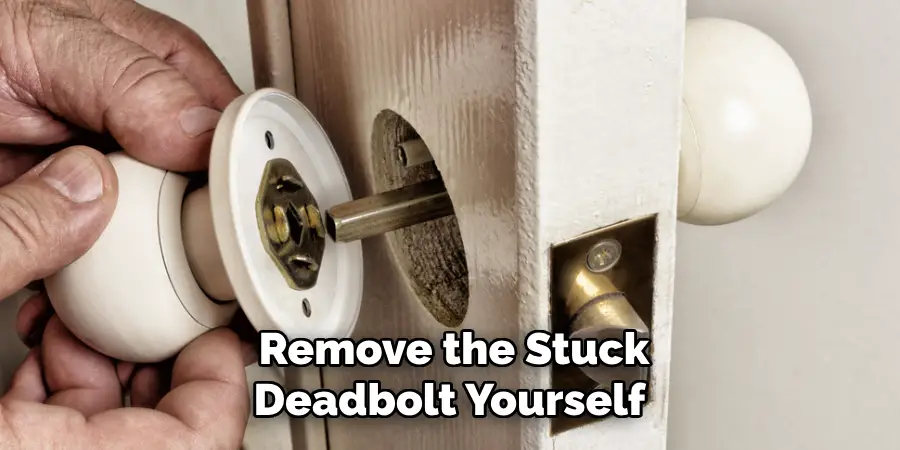
Conclusion
Removing a deadbolt stuck in locked position can be frustrating, but it’s important to stay calm and follow the steps on how to remove deadbolt stuck in locked position outlined above to resolve the issue safely and effectively. Regular maintenance and proper usage can help prevent these issues from occurring, but if you do encounter a stuck deadbolt, don’t hesitate to seek professional help if needed.
Remember, the safety and security of your home should always be a top priority. So, don’t ignore any problems with your locks and address them promptly to ensure that they are functioning properly. Stay safe and secure!
